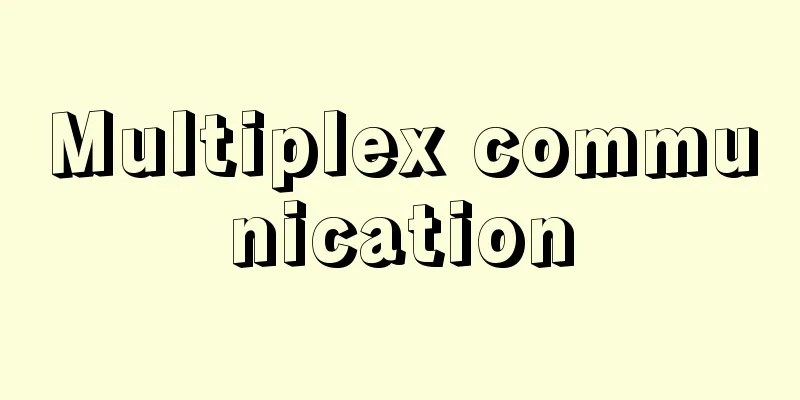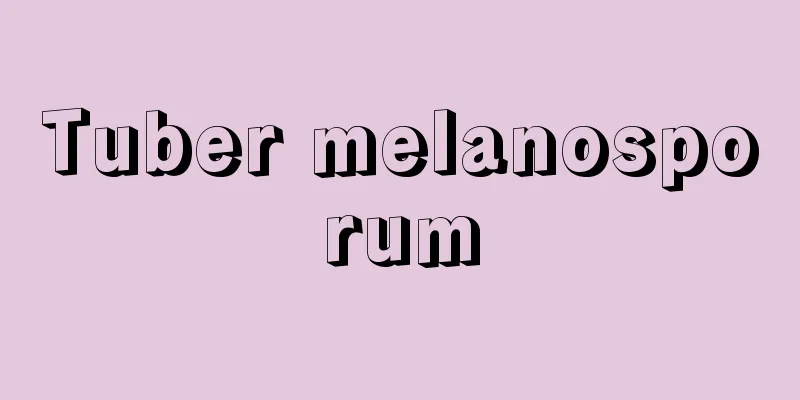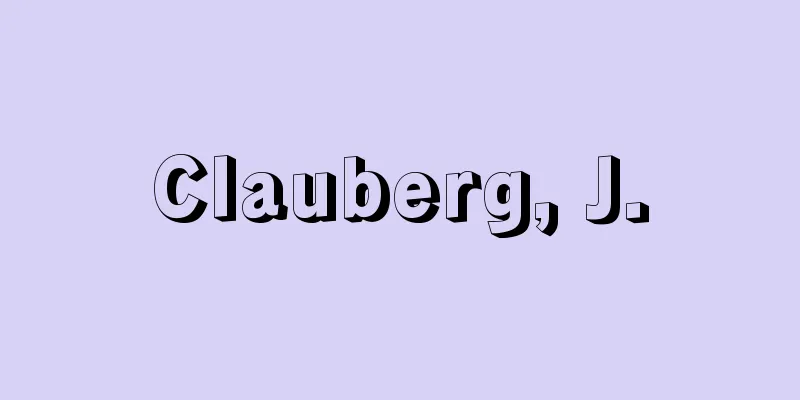Multiplex communication

|
The simultaneous transmission of multiple signals using one transmission medium. This allows for efficient use of expensive transmission media and economical signal transmission. There are three main multiplexing methods: frequency division multiplex (FDM), time division multiplex (TDM), and code division multiplex (CDM). In any of these methods, increasing the number of multiplexed signals requires wideband or high-speed transmission. [Ryo Tsuboi and Tetsuya Miki] Frequency Division MultiplexingThis is achieved by assigning a fixed frequency band to each of many signals and arranging them in order on the frequency axis of a single transmission medium. To achieve this, carrier waves with slightly shifted frequencies are used, and each carrier wave is modulated with an individual signal, so that the frequency bands of the modulated carrier waves do not overlap with each other, allowing multiple signals to be transmitted simultaneously over a single transmission line. Frequency division multiplexing communication was widely used for multiple telephone lines until the 1990s, when telephone networks were digitized. The most common example of frequency division multiplexing in use today is cable television, which uses coaxial cables and optical fiber cables and transmits television signals from around 100 lines simultaneously. [Ryo Tsuboi and Tetsuya Miki] Time Division MultiplexingA method of transmitting multiple signals at different times using the same transmission medium. It is a typical method of multiplexing digital signals, in which an 8-bit (1 byte) code string is usually transmitted cyclically, shifted slightly in time, as one unit, and the original digital signal is obtained by demultiplexing it into 8-bit units at the receiving end. In order for the receiving end to correctly know the time position when multiplexing, a marker on the time axis is required, and the periodic time for one round of multiplexing must be determined. In current digital networks, the periodic time is 125 microseconds. The marker on the time axis that indicates the start of this cycle is called a frame synchronization signal, and is identified using a special code string. A representative example of time division multiplexing communication is the F-10G method using optical fiber cable, which achieves a transmission capacity of 10 gigabits (equivalent to approximately 130,000 telephone lines) with a single optical fiber cable. [Ryo Tsuboi and Tetsuya Miki] Code Division MultiplexingIn digital data transmission and reception, this method encodes data using code patterns several to several tens of times faster than the data rate, and transmits multiplexed data over the same radio frequency band. The code patterns used for each terminal are unique, and by using code patterns that are mutually orthogonal (the product of any two code patterns is 0), the data can be separated for each terminal and transmitted and received as desired. The number of multiplexing is determined by the number of orthogonal code patterns, so basically, if an N -bit code pattern is used, the required frequency band becomes N times and the number of multiplexing becomes N , so the frequency utilization efficiency is equivalent to that of time division multiplexing. In reality, since not all terminals are always sending and receiving data at the same time, it is possible to improve the frequency utilization efficiency, and it is widely used for communication between mobile phone base stations and terminals. [Tetsuya Miki] Source: Shogakukan Encyclopedia Nipponica About Encyclopedia Nipponica Information | Legend |
|
一つの伝送媒体を用いて多数の信号を同時に伝送すること。高価な伝送媒体を有効に利用し、経済的に信号の伝送を行うことができる。多重化の方法としては、周波数分割多重frequency division multiplex(FDM)、時分割多重time division multiplex(TDM)および符号分割多重code division multiplex(CDM)の三つがおもな方法である。いずれの方法によっても多重数を増すには、広帯域あるいは高速の伝送が必要となる。 [坪井 了・三木哲也] 周波数分割多重多数の信号それぞれに定まった周波数帯域を割り当て、それらを一つの伝送媒体の周波数軸上に順序よく並べることにより実現する。このためにはすこしずつ周波数をずらした搬送波を使ってそれぞれの搬送波を個別の信号で変調し、変調された搬送波の周波数帯が互いに重畳することのないようにして、一つの伝送路で多数の信号を同時に伝送する。周波数分割多重通信は、電話ネットワークがデジタル化される1990年代まで多重電話回線に広く使われており、もっとも多重数の多い例として同軸ケーブルを用いたC-60M方式があり、1本の同軸ケーブルにより1万0800回線の伝送容量を実現していた。現在使われている周波数分割多重の代表的な例は、同軸ケーブルや光ファイバーケーブルを用いたケーブルテレビであり、100回線程度のテレビ信号を同時に伝送している。 [坪井 了・三木哲也] 時分割多重同一の伝送媒体を用いて複数の信号を別々の時間に伝送する方法である。デジタル信号の代表的な多重通信の方法であり、通常は8ビット(1バイト)の符号列を1単位として時間的にすこしずつずらして周期的に伝送し、受信側ではそれを逆に時間的に8ビットずつ分離することにより、元のデジタル信号を得る。受信側で、多重したときの時間位置を正しく知るには、時間軸上の目印が必要であり、多重が1巡する周期時間が定まっている必要がある。現在のデジタルネットワークでは、周期時間は125マイクロ秒である。この周期のスタートを示す時間軸上の目印をフレーム同期信号といい、特別な符号列を用いて識別している。 時分割多重通信の代表例としては光ファイバーケーブルを用いたF-10G方式があり、1本の光ファイバーケーブルで10ギガビット(電話換算で約13万回線)の伝送容量を実現している。 [坪井 了・三木哲也] 符号分割多重デジタル通信の情報データ送受信において、データ速度の数倍から数十倍の速度の符号パターンで符号化して、同一の無線周波数帯を用いて多重通信を行う方法である。端末ごとに使用する符号パターンに特徴があり、相互に直交(任意の二つの符号パターンを乗算したとき0になること)する符号パターンを用いることで、端末ごとに分離して目的とするデータの送受信を行うことができる。 多重化数は直交する符号パターンの数で決まるので、基本的にはNビットの符号パターンを用いると、所要周波数帯域はN倍になり、多重数はNとなるので、周波数利用効率は時分割多重と同等である。現実にはすべての端末がいつも同時にデータの送受信をしているわけではないので、周波数利用効率をあげることが可能であり、携帯電話の基地局と端末間の通信に広く用いられている。 [三木哲也] 出典 小学館 日本大百科全書(ニッポニカ)日本大百科全書(ニッポニカ)について 情報 | 凡例 |
<<: Multiple conversion device - tajuhenkansouchichi
>>: Daśaharā (English spelling)
Recommend
Landscape painting
A modern concept of Yamato-e. It defines seasonal ...
Elbe River Navigation Ordinance
…The territorial governments made efforts to elim...
800 Women's Country - Happyakusokufukoku
A Tu lord state located outside the border of Yunn...
Copy - Utsushi
1. To copy or replicate a work of art. 2. A docume...
slow-down
…The Japanese word 'satogyō' corresponds ...
God of wealth
In China, a god believed to have the power to accu...
Székely people (English spelling)
A Hungarian group that has had a unique historical...
Wood - Mokhon
Among seed plants, those whose above-ground stems ...
Red parrot fish
A marine fish belonging to the order Perciformes ...
Hatsuuma - Hatsuuma
It refers to the first day of the horse month in ...
Subkī (English spelling)
1327‐70 Egyptian writer. Born into the prestigious...
Romanist (English spelling) Romanisten [Netherlands]
16th century Netherlandish painters who studied in...
Wichita - Uichita (English spelling)
A commercial and industrial city in the south-cen...
Insult - bujokuzai
Even if facts are not stated, a person who openly...
homestead
…This is almost the same as in Germany. (1) Farms...









